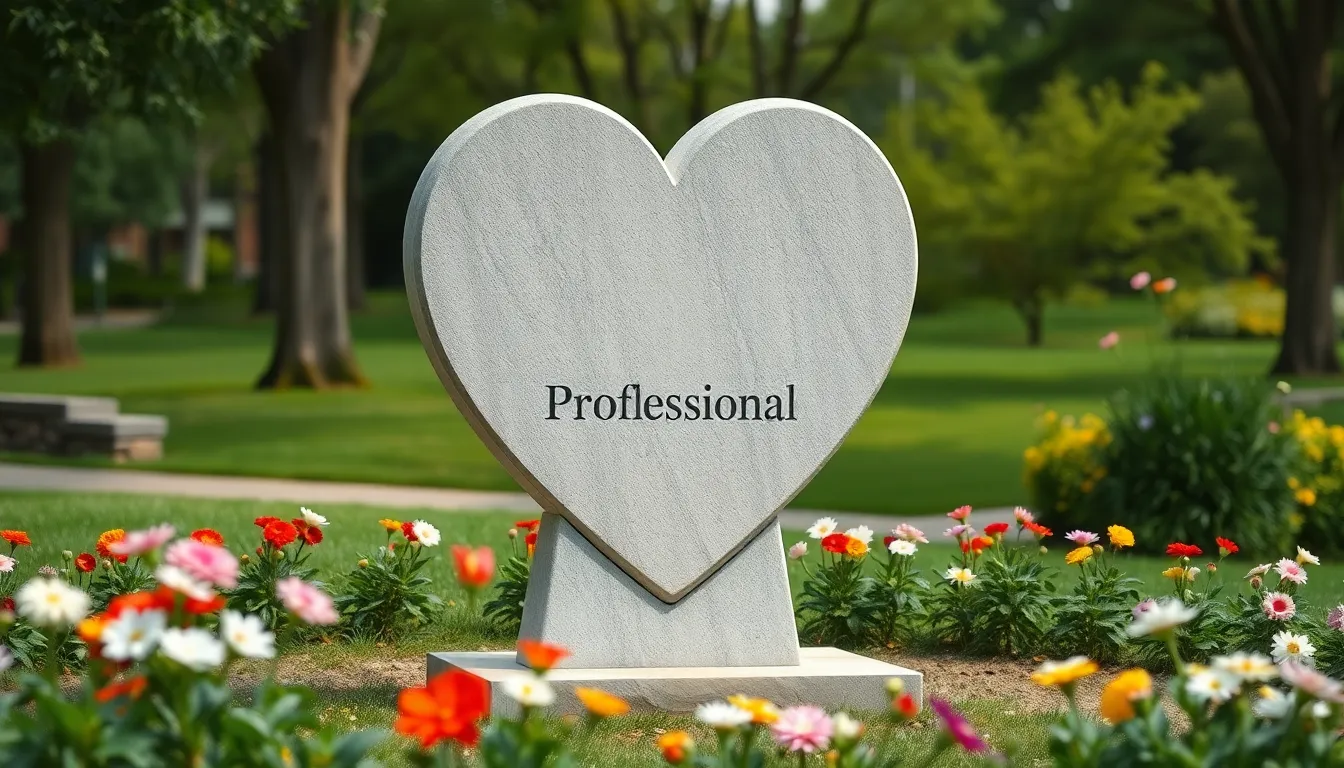The Best Fluffy Pancakes recipe you will fall in love with. Full of tips and tricks to help you make the best pancakes.

Heart Sculpture: Discover the Art of Love That Transforms Spaces and Touches Hearts
In a world where love often feels like a fleeting concept, heart sculptures stand as timeless symbols of affection and creativity. These artistic masterpieces capture the essence of romance while adding a splash of personality to any space. Whether it’s a charming garden centerpiece or a striking urban installation, heart sculptures invite onlookers to pause and appreciate the beauty of love in its many forms.
Overview of Heart Sculpture
Heart sculptures serve as powerful icons of affection and artistic expression. These creations manifest in various forms, from intricate metalwork to vibrant stone carvings. Various artists interpret the heart’s shape uniquely, allowing for a diverse range of styles and techniques.
In many cultures, heart sculptures symbolize love, compassion, and connection. They often adorn public spaces, drawing attention and inviting reflection among onlookers. Well-known examples include those found in parks, where visitors engage with the art and connect emotionally.
Some heart sculptures feature engravings or inscriptions that personalize their message. These additions enhance the narrative, catering to specific occasions such as weddings, anniversaries, or memorials. An example includes a heart sculpture installed in a community to commemorate lost loved ones, offering a space for remembrance.
Materials used for heart sculptures vary widely, impacting their visual and tactile qualities. Artists choose from metal, glass, wood, or stone to evoke different emotions. Each material carries its own symbolism and texture, influencing how viewers perceive the art.
Locations where heart sculptures are displayed can impact their resonance. Urban areas benefit from large installations that engage a wide audience, while intimate settings create personal connections. The placement of these sculptures often enhances their significance, creating a dialogue between art and its environment.
Heart sculptures continuously inspire artists and audiences alike. They invite interpretation and encourage exploration of love’s many manifestations. By representing universal feelings, heart sculptures connect deeply with individuals across varied backgrounds.
History of Heart Sculpture

Heart sculptures hold a rich history, reflecting artistic expressions across various cultures and time periods.
Cultural Significance
Heart sculptures serve as potent symbols in many cultures, representing love, compassion, and connection. In ancient civilizations, these forms communicated deep emotional ties, often appearing in religious and ceremonial contexts. For instance, in Greek mythology, heart-shaped elements symbolized divine love and beauty. In contemporary society, artists leverage these symbols to foster emotional connections in public art. These sculptures frequently incorporate personal messages and themes, enhancing their significance for specific occasions, such as weddings and memorials. Overall, heart sculptures resonate universally, transcending cultural boundaries to inspire love and affection.
Evolution Through Time
Heart sculptures evolved significantly, reflecting changing artistic styles and societal values. Initially, early sculptors focused on simplistic representations, emphasizing form over detail. With time, artists began to explore intricate designs, incorporating various materials like stone, metal, and glass. The Renaissance marked a turning point, inspiring artists to create more lifelike representations while intertwining symbolism with artistry. Modern artists approach the heart shape with greater creativity, experimenting with abstract forms and innovative materials. These changes highlight the adaptability of heart sculptures, mirroring societal shifts and personal expressions of love across generations.
Popular Heart Sculptures
Heart sculptures manifest in various captivating forms, showcasing artistic interpretation and emotional depth. These pieces often draw attention and admiration in both public spaces and private collections.
Iconic Examples
“Love” by Robert Indiana stands as one of the most recognizable heart sculptures. This piece, featuring bold colors and unique typography, symbolizes love in a profound manner. In Chicago, the “The Chicago Heart” by artist Jim Bambeck reflects local culture and community spirit. “The Embrace” in Boston commemorates Martin Luther King Jr., presenting a powerful message of unity and love. Each sculpture embodies distinct narratives, influencing viewer perception and connecting deeply with emotions.
Artists and Their Styles
Contemporary sculptors showcase heart designs in various styles. Alexander Calder incorporates movement into his heart sculptures, fusing kinetic art with emotion. Jeff Koons employs shiny materials to create playful interpretations that attract admiration. Sheila Klein’s work often merges light and color, crafting immersive experiences around heart shapes. Artists approach this theme with diverse methods, enriching the world of heart sculptures and inviting personal reflection.
Creating a Heart Sculpture
Creating a heart sculpture involves selecting the right materials and employing various artistic techniques. Artists choose their components based on the desired aesthetic and emotional impact.
Materials Used
Various materials serve as themes for heart sculptures. Metal, including stainless steel and bronze, provides durability and a modern aesthetic. Stone, such as marble and granite, offers timeless elegance with natural textures. Wood brings warmth and an organic feel to sculptures. Additionally, glass presents unique opportunities for light interaction, capturing shadows and reflections. Polymers and resins allow for innovative forms while ensuring versatility. Each material contributes distinct qualities that enhance the sculpture’s overall expression of love.
Artistic Techniques
Artists employ numerous techniques to bring heart sculptures to life. Traditional carving methods, like chipping and sanding, shape solid materials for intricate designs. Techniques like welding join metal pieces to create dynamic forms. Painting and coloring infuse sculptures with vibrancy, celebrating individual styles. Assemblage art combines various elements into a cohesive sculpture, showcasing creativity and innovation. Furthermore, modern techniques, such as 3D printing, expand possibilities, allowing for complex designs to emerge. These diverse artistic approaches ensure that heart sculptures resonate with viewers on emotional and aesthetic levels.
Heart Sculpture in Public Spaces
Heart sculptures enhance public spaces, transforming environments into vibrant and engaging areas. Cities worldwide use these artistic pieces to convey messages of love, community, and connection. Notable installations provide focal points, attracting visitors while promoting positivity.
Artists employ various techniques to create heart sculptures for these settings. Metal, stone, wood, and glass serve as popular materials, each contributing unique aesthetics. For example, large metal sculptures might shine under the sun while intricate stone pieces exhibit craftsmanship and texture.
Public art initiatives incorporate heart sculptures into urban planning projects. Such installations often reside in parks, plazas, and along waterfronts, encouraging social interaction among individuals. Local governments and organizations collaborate with artists to select sites that foster community engagement.
Iconic examples abound in popular cities. In Philadelphia, the “Love” sculpture by Robert Indiana stands as a cultural landmark, inviting countless photos and expressions of affection. Chicago boasts “The Chicago Heart,” symbolizing local pride with its bold colors and design. Boston’s “The Embrace” pays tribute to love’s enduring power and connection.
Community involvement plays a significant role in these projects. Residents collaborate on the design process, offering input that reflects collective values. Engaging local artisans adds authenticity, ensuring heart sculptures resonate with the community.
Heart sculptures not only beautify public spaces but also foster emotional connections. They evoke feelings of joy, love, and unity among viewers. Such artworks invite contemplation and dialogue, enriching the cultural landscape of cities and promoting an inclusive atmosphere.
Conclusion
Heart sculptures stand as timeless expressions of love and creativity. They not only enhance public spaces but also foster emotional connections among individuals. Each piece reflects the unique vision of the artist while resonating with the viewer’s personal experiences.
From ancient civilizations to modern interpretations, these sculptures continue to evolve, adapting to new materials and techniques. Their presence in urban environments transforms ordinary spaces into vibrant areas filled with meaning.
As heart sculptures inspire artists and audiences alike, they invite ongoing exploration of love’s many forms and the connections that bind us all.
